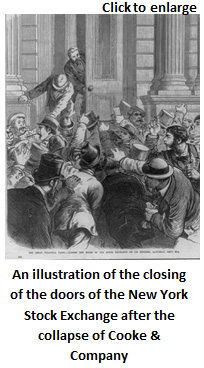
Source: The Great Financial Panic of 1873—
Closing the door of the Stock Exchange on its
members, Saturday, Sept. 20th. Library of Congress

Source: The Great Financial Panic of 1873—
Closing the door of the Stock Exchange on its
members, Saturday, Sept. 20th. Library of Congress
The enthusiasm over the railroad industry came to a crashing halt in 1873. The great success of the first transcontinental railroad led to people trying to build another one. However, there was a worldwide credit crisis and the major bank financing the second railroad, Jay Cooke and Company, went bankrupt on Sept. 18 sparking the Panic of 1873.
The bankruptcy of Cooke and Company sparked a chain reaction that had disastrous consequences for the nation’s economy. Trading halted on the New York Stock Exchange for 10 days afterwards. Many other banks started to fail, which in turn led to the failure of the railroads they were supporting. The failure of the railroads caused other companies that supported the building of the railroads to go under, and so on.
Altogether, 89 of the country’s 364 railroads went bankrupt within two years. A total of 18,000 businesses closed.
The average worker, especially in the major cities like New York and Chicago felt the sting of the business failures the most. By 1876, unemployment in the United States reached nearly 15%.
The Panic of 1873 became part of a worldwide depression that lasted until 1879.
Reflection: How do you think the ordinary worker reacted to losing their job after the Panic of 1873? What do you think were the consequences for them?
Interactive popup. Assistance may be required. Some people were saddened and worried when they lost their job. People became homeless and could not support their families. Other people became very angry and were joined by people who still had a job but faced worse working conditions due to the economic downturn. This culminated in the Great Railroad Strike of 1877, when thousands of workers across the country brought the railroad industry to a standstill by refusing to work. President Hayes sent federal troops to force people back to their jobs. 
Examine the two newspaper clippings from 1873. The advertisement is for a Washington D.C. shop called Opposition Store at 476 Pennsylvania Avenue (which is the same avenue as whatInteractive popup. Assistance may be required. The White House ?). The picture on the right is a scene from New York City outside of Jay Cooke’s office building shortly after declaring bankruptcy. Click each picture to enlarge it and answer the questions below in your notes.
?). The picture on the right is a scene from New York City outside of Jay Cooke’s office building shortly after declaring bankruptcy. Click each picture to enlarge it and answer the questions below in your notes.
What are the immediate “Effects of the Panic” for Opposition Store?
Interactive popup. Assistance may be required. Opposition Store dramatically lowered their prices on jewelry to one dollar on some potentially nice merchandise like gold chains and it is also selling books at substantial discount.
Using what you know about the Panic of 1873, why do you think Opposition Store is taking the action it is doing?
Interactive popup. Assistance may be required. The Opposition Store is probably lowering their prices in part because people have less money due to the Panic if 1873, or at least, it is a good gimmick to attract people to come into their store.
How did the people of New York City react to Jay Cooke and Company declaring bankruptcy, according to the picture?
Interactive popup. Assistance may be required. The people of New York are surrounding the buildings. Some people look very concerned, others angry, and a few are pointing at the Jay Cooke and Company building perhaps as a source of their trouble. 
What do both pictures together tell us about why this event was called the Panic of 1873?
Interactive popup. Assistance may be required. The pictures together show a small part about why this event is called a panic. People are spilling out into the streets. One business is dramatically lowering their prices. These are just two examples, but they show people are behaving differently in response to the economic events. 
Connection to Current Events The over-investment in railroads that ultimately produced the Panic of 1873 was an example of what economists call a “bubble.” During a bubble, people invest in a particular item and its value keeps increasing, so people put more money into it hoping to take advantage of the rising prices. This eventually inflates the price to far more than the good is worth. Then, the bubble breaks and people lose a lot of money. Many bubbles have occurred in U.S. history. The economic downturn that started in 2008 was in large part because of a bubble in the prices of houses. People paid more money for their homes than they were worth, and banks made many bad loans because of a belief in rising home prices. Much like the piercing of the railroad bubble that took down Jay Cooke & Company, the bursting of the housing bubble in 2008 brought down one of the world’s largest financial companies, Lehman Brothers. |